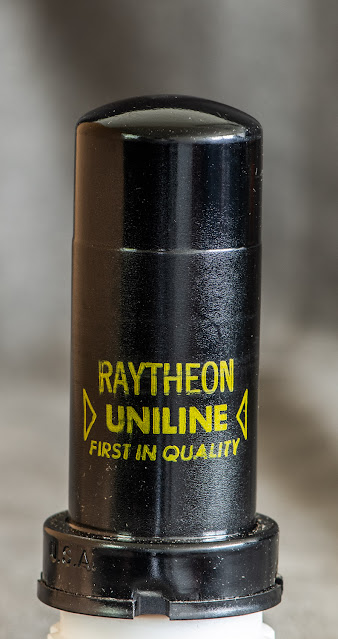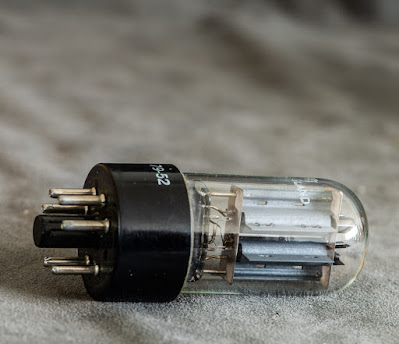Hi!
Since I just showed a set of 2A3 amplifiers which use the 6N7 as driver I thought it is a good idea to have a look at this tube again in detail.
The 6N7 was one of the first tubes which I presented and was shown in the Tube of the Month post in February 2011. But that was a rather short post with only a few photos. So let's have a look at it again.
The 6N7 is a double triode. Both triodes have the cathodes internally connected. The tube was designed with two applications in mind. One of them a Class B output stage and the other as Class A driver with both halves connected in parallel. The latter is the way I am using this tube to drive small output tubes like the 45, 46, 2A3 and also the 6CB5A. The 6N7 has an octal base. The pinout can be seen on the left. With both triodes in parallel it has a plate resistance of 10 kOhm which is just low enough to use it with interstage transformers. It can also be used with inductive or restive load of course. Due to the highish plate resistance a high quality interstage transformer is needed with sufficient primary inductance to allow good frequency response. The tube uses a 6,3V heater which needs 0.8A. The amplification factor is 35 which is a good value to be able to build 2 stage amplifiers with the aforementioned output tubes and still have a good input sensitivity. For the complete technical details refer to the General Electric data sheet. The 6N7 was made in both ST shoulder type glass (6N7G) and also tubular straight sided glass (6N7GT) as well as with metal shell (6N7). Before we look at the various tubes, let's examine the linearity of the tube in Class A mode. Here the curve set from the data sheet:And here the plate curves taken with the tracer with both halves wired in parallel:
Since I use the 6N7 a lot I have a big stash from different manufacturers.
This tube came in a nice box with the RCA 'meatball' logo.
Sealed boxes:
This type of packaging is the only way to be sure the tube is NOS and not used. The tubes can be tested in box without tearing the carton.
6N7 made for the military:
The box on the right says Canadian Armed Services but looks like RCA made.
Sylvania 6N7G:
Sylvania 6N7GT:
Metal 6N7 made by Sylvania:
National Union 6N7G and 6N7:
Ken-Rad:
Part of the glass is blacked.
Metal 6N7 by Ken-Rad:
Various glass and metal 6N7 made by Raytheon:
The next two are rebranded 6N7GT:
This metal 6N7 came in an International Service Master box (a parts supplier) and has no markings on the tube:
Amperex:
Visseux 6N7GT made in France:















































































































Hi Thomas,
ReplyDeleteThanks for this update.. That’s a cool collection. The Ken-Rad with the partially blackened glass looks sweet.
Is the 6N7 a driver you would consider for a 10Y or 801A amp? Thanks!
Yes would go nicely with 801A or 10Y
DeleteThese are good. I am using a pair in an old Bogen monster instead of the paralleled 6SN7s to drive the output grids (AB2 style).
ReplyDeleteThe anodes are connected direct to the 320V HT, the cathodes go to the 807 output valve grids thru a CT choke.
I would say, for that they are perfect, especially as I have converted the amp to a QUAD (at 900V) instead of the original matched pair.
175W who would complain about that??